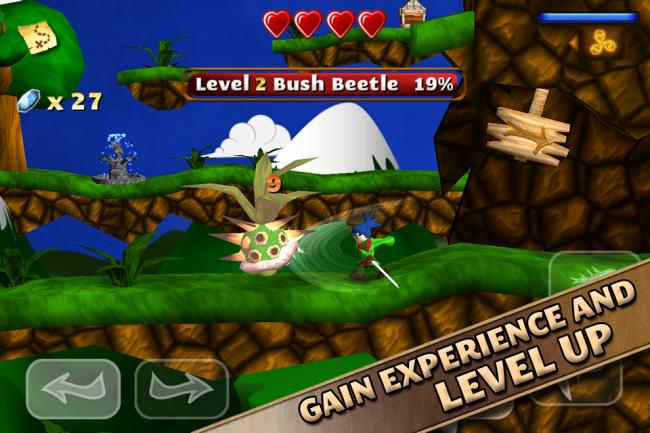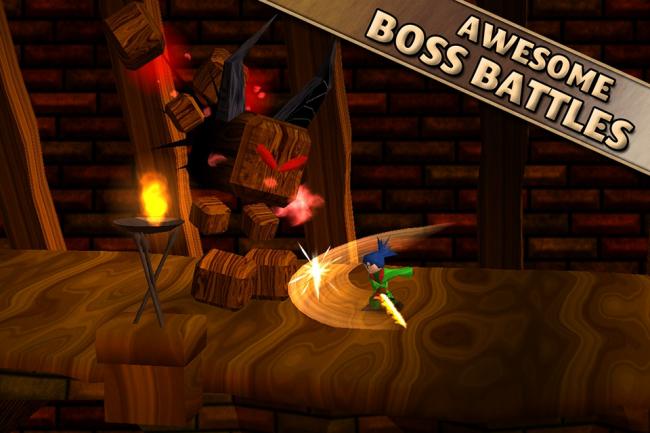- Wondering how to get Monopoly GO! free rolls? Well, you’ve come to the right place. In this guide, we provide you with a bunch of tips and tricks to get some free rolls for the hit new mobile game. We’ll …
Best Roblox Horror Games to Play Right Now – Updated Weekly
By Adele Wilson
Our Best Roblox Horror Games guide features the scariest and most creative experiences to play right now on the platform!The BEST Roblox Games of The Week – Games You Need To Play!
By Sho Roberts
Our feature shares our pick for the Best Roblox Games of the week! With our feature, we guarantee you'll find something new to play!Type Soul Clan Rarity Guide – All Legendary And Common Clans Listed!
By Nathan Ball
Wondering what your odds of rolling a particular Clan are? Wonder no more, with my handy Type Soul Clan Rarity guide.
Swordigo Review
It’s always nice to see an iOS game riff on classic video gaming franchises without openly ripping off themes or visual motifs. Swordigo from TouchFoo manages to recall elements of beloved console games such as Zelda II: The Adventure of Link, Metroid, and Castlevania: Symphony of the Night with action/platformer/RPG aspects set around original yet familiar characters, tropes, and conventions. Ideally, that should pique your interest with a mild bemusement noise.

Swordigo channels the spirit of classic NES-era platformers with fantastic results
It’s always nice to see an iOS game riff on classic video gaming franchises without openly ripping off themes or visual motifs. Swordigo from TouchFoo manages to recall elements of beloved console games such as Zelda II: The Adventure of Link, Metroid, and Castlevania: Symphony of the Night with action/platformer/RPG aspects set around original yet familiar characters, tropes, and conventions. Ideally, that should pique your interest with a mild bemusement noise.
When long-forgotten conquering creatures return to cause havoc, it’s up to the player to take up a sword, learn a little magic, and journey across the land to recover the powerful weapons necessary to banish the beasts once and for all. It’s familiar territory, yes, but the story serves merely as a framing device for romping through forests, caves, dungeons, and other dangerous environments while slashing at swooping bats, charging horned monsters, crawling spiders, and other dangerous forces.
Defeating enemies earns experience points which, in the grand tradition of games such as Zelda II, allow the player to level up and customize one’s character with an emphasis on life, attack power, or magical ability. Items can be collected, blocks must be carried to place on switches, treasure chests exist to be looted (complete with a happy little discovery tone), and so on. It’s well-worn territory, but why complain when the overall quality is solid?
Controls are easily handled with on-screen buttons for left and right movement in addition to buttons for sword slashing, jumping, and magic. An additional button allows for switching between magical powers (such as bolts or bombs, for instance), and movement is well-executed, which is to be commended in a genre that typically suffers from sloppy touch screen controls.
Swordigo presents plenty of opportunities for backtracking, as players will have to return to previous areas to open new paths once additional weapons are earned. Anyone comfortable with the “Metroidvania” style of platforming will feel right at home here (and, in true Metroidvania fashion, a built-in mapping system keeps track of the relation between the realm’s different areas).


Most of Swordigo is strong and well-produced, but there are a few small hassles that one must handle. Whenever the player falls into a bottomless pit, the protagonist will respawn at the last piece of solid ground. Sometimes that solid ground is actually a trap. Consider a respawn spot in the Forgotten Keep area that is actually packed with spikes in the floor, for instance.
Moreover, the protagonist is knocked backward when hit by an enemy without enjoying the traditional moment of invincibility. All too often, players must deal with knockback that kicks the hero into another enemy which then kicks into another enemy, etc., until the dreaded Game Over screen appears (thankfully players can restart near the point of death). These seem like unexpected incidents that were missed during development and do not negatively impact the overall fun factor, but can be a bit frustrating at key moments.
Swordigo‘s only real failing is that its presentation is horribly derivative. The characters aren’t memorable, nor do any of the regions particularly stand out. Anyone looking for a new mascot-type character to champion will be disappointed.
Despite its generic nature, Swordigo is an enjoyable game in the spirit of classic console games delivered in a handheld package perfect for long play sessions or quick bite-sized moments. Anyone who looks back at the Nintendo Entertainment System era of platformer RPGs and remarks “they don’t make ’em like this anymore” would do well to grab an iOS device and check out this adventure. As it turns out, someone does still make ’em like this.

The good

The bad
More articles...
Monopoly GO! Free Rolls – Links For Free Dice
By Glen Fox
Wondering how to get Monopoly GO! free rolls? Well, you’ve come to the right place. In this guide, we provide you with a bunch of tips and tricks to get some free rolls for the hit new mobile game. We’ll …Best Roblox Horror Games to Play Right Now – Updated Weekly
By Adele Wilson
Our Best Roblox Horror Games guide features the scariest and most creative experiences to play right now on the platform!The BEST Roblox Games of The Week – Games You Need To Play!
By Sho Roberts
Our feature shares our pick for the Best Roblox Games of the week! With our feature, we guarantee you'll find something new to play!Type Soul Clan Rarity Guide – All Legendary And Common Clans Listed!
By Nathan Ball
Wondering what your odds of rolling a particular Clan are? Wonder no more, with my handy Type Soul Clan Rarity guide.







